
TUGELA PRIVATE GAME RESERVE, COLENSO, NATAL, SOUTH AFRICA, NOVEMBER 2010: Images of a female rhino who 4 months ago survived a brutal dehorning by poachers who used a chainsaw to remove her horns and a large section of bone in this area of her skull, Natal, South Africa, November 9, 2010. The poachers surveyed the area by helicopter, mapped out the movements of the Rhino and the Guards and then darted the animal and hacked of the horn with a chainsaw. In an act of callous brutality they left the animal alive when they left with the horns. This Rhino was consequently found the next day wandering around in unimaginable pain. She also had a young 4 week old calf who was seperated in the incident and subsequently died of starvation and dehydration. The female adult miraculously survived the dehorning and with some vetrinary supervision has gone on to join up with a male bull who accompanies her and helps her to survive. (Photo by Brent Stirton/Reportage for WWF.)

SOUTH AFRICA, MAY 2011: A secret, secure Rhino horn safe which functions as a half-way storage for horns collected from National and Provincial Parks within South Africa, May 05, 2011. The location is a closely-guarded secret as there is a history of these locations being targeted by armed gangs who are attracted to the high value of the horn on the illegal market. The rise of the Asian middle class and the current Cities legislation regarding Rhino horn has led to these horns becoming very valuable, a large horn going for as much as $150 000. As such they are in high demand in organised crime circles. (photo by Brent Stirton/Reportage for National Geographic Magazine.)

MESSINA, SOUTH AFRICA, MARCH 2011: White Rhino meat hangs in cold storage after a morning hunt on Dawie Groenewald's hunting lodge in Messina, South Africa, March 25 2011. Groenewald along with his wife and 11 of his employees are currently accused of involvement in the illegal Rhino Horn trade. He is suspected of killing a number of rhino on his farm and de-horning them without permits for the conservation authority. Groenewald denies this but has become the posterboy for the Rhino poaching epedemic sweeping South Africa. He is free on bail and authorities have not confiscated his helicopter or his guns. He continues to conduct hunts on his property for a majority Vietnamese and Eastern European clientele. Groenewald claims that he would prefer to conduct green hunts, with anathetics administered by dart and subsequent dehorning replacing killing the animal but admits that there is a section of the Asian marker that prefers horn that comes from an animal which has been shot. Groenewald voice concern over the increasingly bureacratic permitting system in South Africa which he claims makes it very difficult to make money from the expensive business of breeding Rhino. He states that you cannot make money from a dehorned Rhino given the current ban on the horn trade, you have to kill the animal in a legal hunt in order to secure the horn. Groenewald makes a direct connection to this and the rise in poaching. Groenewald is no stranger to controvery, being arrested in the US in 2009 on a suspect stuffed Leopard import document as well as connections to other suspect dealings concerning wildlife. Groenewald voices confidence over the upcoming trial, stating a lack of evidence on the part of the state. (Photo by Brent Stirton/Reportage for National Geographic Magazine.)

MESSINA, SOUTH AFRICA, MARCH 2011: A White Rhino skin is salted for curing after a morning hunt on Dawie Groenewald's hunting lodge in Messina, South Africa, March 25 2011. Groenewald along with his wife and 11 of his employees are currently accused of involvement in the illegal Rhino Horn trade. He is suspected of killing a number of rhino on his farm and de-horning them without permits for the conservation authority. Groenewald denies this but has become the posterboy for the Rhino poaching epedemic sweeping South Africa. He is free on bail and authorities have not confiscated his helicopter or his guns. He continues to conduct hunts on his property for a majority Vietnamese and Eastern European clientele. Groenewald claims that he would prefer to conduct green hunts, with anathetics administered by dart and subsequent dehorning replacing killing the animal but admits that there is a section of the Asian marker that prefers horn that comes from an animal which has been shot. Groenewald voice concern over the increasingly bureacratic permitting system in South Africa which he claims makes it very difficult to make money from the expensive business of breeding Rhino. He states that you cannot make money from a dehorned Rhino given the current ban on the horn trade, you have to kill the animal in a legal hunt in order to secure the horn. Groenewald makes a direct connection to this and the rise in poaching. Groenewald is no stranger to controvery, being arrested in the US in 2009 on a suspect stuffed Leopard import document as well as connections to other suspect dealings concerning wildlife. Groenewald voices confidence over the upcoming trial, stating a lack of evidence on the part of the state. (Photo by Brent Stirton/Reportage for National Geographic Magazine.)

MESSINA, SOUTH AFRICA, MARCH 2011: Dawie Groenewald, Game farmer and Professional Hunter, in his hunting lodge on his farm in Messina, South Africa, March 25 2011. Groenewald along with his wife and 11 of his employees are currently accused of involvement in the illegal Rhino Horn trade. He is suspected of killing a number of rhino on his farm and de-horning them without permits for the conservation authority. Groenewald denies this but has become the posterboy for the Rhino poaching epedemic sweeping South Africa. He is free on bail and authorities have not confiscated his helicopter or his guns. He continues to conduct hunts on his property for a majority Vietnamese and Eastern European clientele. Groenewald claims that he would prefer to conduct green hunts, with anathetics administered by dart and subsequent dehorning replacing killing the animal but admits that there is a section of the Asian marker that prefers horn that comes from an animal which has been shot. Groenewald voice concern over the increasingly bureacratic permitting system in South Africa which he claims makes it very difficult to make money from the expensive business of breeding Rhino. He states that you cannot make money from a dehorned Rhino given the current ban on the horn trade, you have to kill the animal in a legal hunt in order to secure the horn. Groenewald makes a direct connection to this and the rise in poaching. Groenewald is no stranger to controvery, being arrested in the US in 2009 on a suspect stuffed Leopard import document as well as connections to other suspect dealings concerning wildlife. Groenewald voices confidence over the upcoming trial, stating a lack of evidence on the part of the state. (Photo by Brent Stirton/Reportage for National Geographic Magazine.)

MESSINA, SOUTH AFRICA, APRIL 2011: Accused Rhino farmer Dawie Groenewald, his wife and 11 employees attend a hearing on their case in the Messina Magistrates Court, South Africa, 11 April 2011. Groenwald is accused of transgressing the Endangered Species act after a number of unaccounted for Rhino carcasses were found on his property, a game ranch and hunting facility in Messina in far North East South Africa. (Photo by Brent Stirton/Reportage for National Geographic.)

MESSINA, SOUTH AFRICA, APRIL 2011: Accused Rhino farmer Dawie Groenewald, his wife and 11 employees attend a hearing on their case in the Messina Magistrates Court, South Africa, 11 April 2011. Groenwald is accused of transgressing the Endangered Species act after a number of unaccounted for Rhino carcasses were found on his property, a game ranch and hunting facility in Messina in far North East South Africa. (Photo by Brent Stirton/Reportage for National Geographic.)
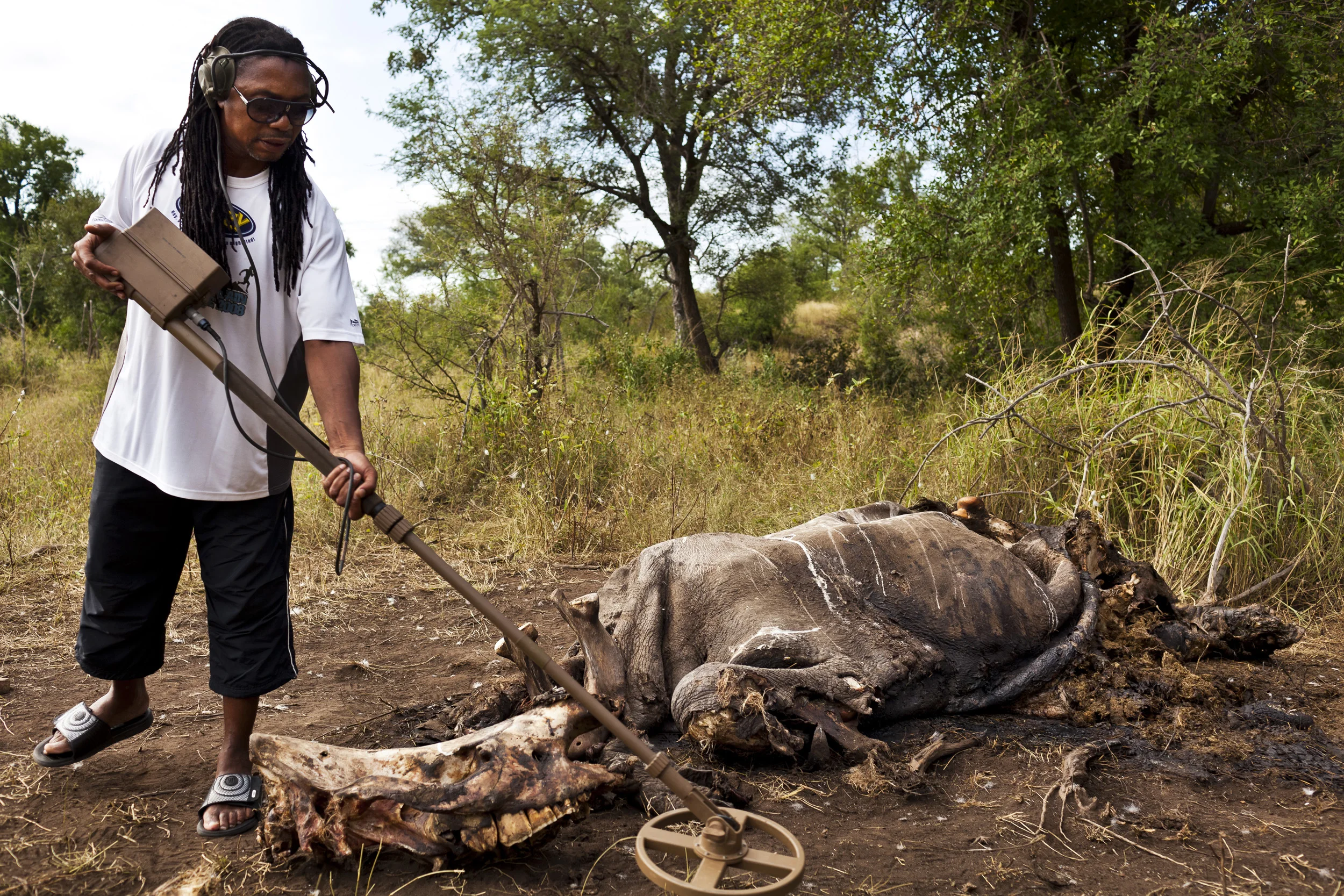
HOEDSPRUIT, SOUTH AFRICA, APRIL 2011: An investigation team from SanParks, Nature conservation and private security investigators inspect two 5 day old poached White Rhino carcasses on a private game farm outside Hoedspruit in North West South Africa, April 7 2011. The Rhino were both shot with a '375 hunting rifle equipped with a silencer by a professional who used a single bullet on each animal. The horns on both were removed using a knife blade. The investigators swept the bodies with a metal detector and recovered an intact bullet and part of a blade. (Photo by Brent Stirton/Reportage for National Geographic.)
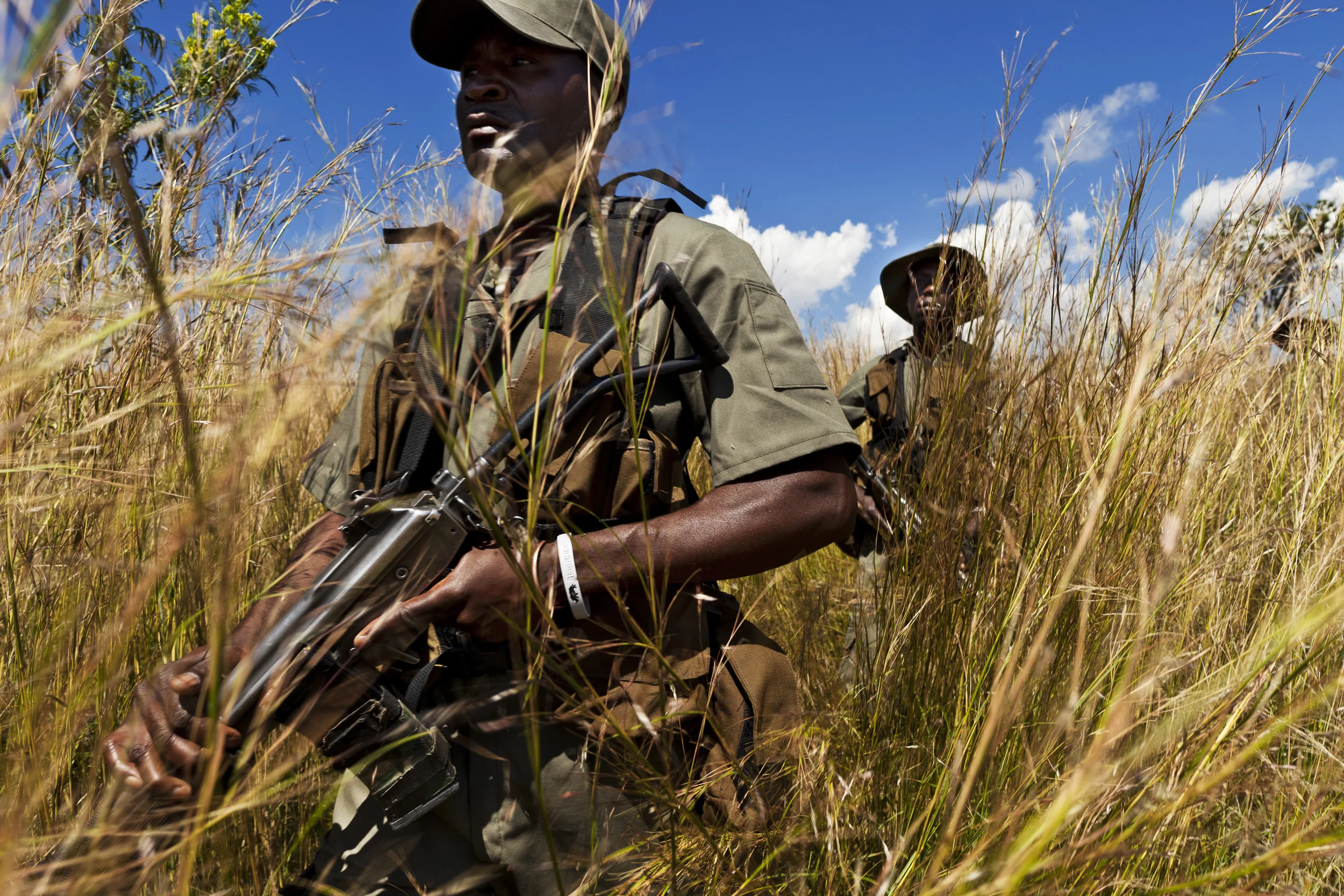
VAALWATER, NORTHERN SOUTH AFRICA, MARCH 2011: Members of private security firm "Quemic" patrol and maintain anti-poaching observation points on Welgevonden, a private game ranch with Rhino in the Vaalwater area of Northern South Africa, March 23 2011. The last Rhino poaching incident on this property occured on this property over 3 yeas ago as a result of the professionalisation of security. Not all Rhino owners can afford this financial commitment, leaving other wide open to organised professional Horn poachers. (photo by Brent Stirton/Reportage for National Geographic Magazine.)

VICTORIA FALLS, ZIMBABWE, APRIL 2011: Images of The International Anti-Poaching Foundation leading a Pro-bono training workshop for Rangers who have come from all over Zimbabwe, April 5, 2011. Led by Australian Damien Mander, 31, a former Special Operations soldier in the Australian military, the IAPF is teaching anti-poaching techniques which include tracking, self-defence, observation positions, weapons training and patroling techniques including tracking, ambush and arrest techniques. The work is largely pro-bono and is supported by donations. (Photo by Brent Stirton/Reportage for National Geographic Magazine.)
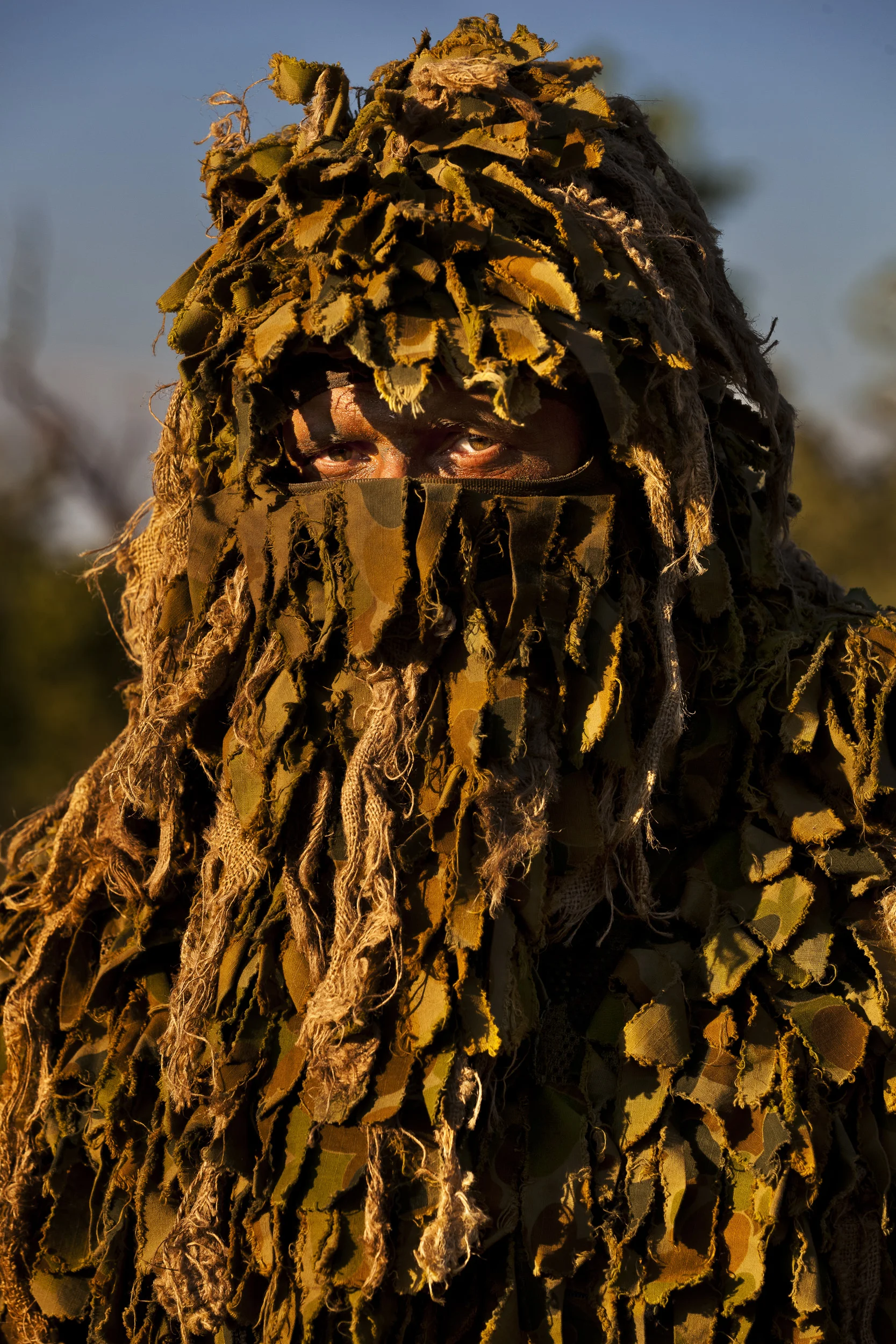
VICTORIA FALLS, ZIMBABWE, APRIL 2011: Images of The International Anti-Poaching Foundation leading a Pro-bono training workshop for Rangers who have come from all over Zimbabwe, April 5, 2011. Led by Australian Damien Mander, 31, a former Special Operations soldier in the Australian military, the IAPF is teaching anti-poaching techniques which include tracking, self-defence, observation positions, weapons training and patroling techniques including tracking, ambush and arrest techniques. The work is largely pro-bono and is supported by donations. (Photo by Brent Stirton/Reportage for National Geographic Magazine.)

VICTORIA FALLS, ZIMBABWE, APRIL 2011: Images of The International Anti-Poaching Foundation leading a Pro-bono training workshop for Rangers who have come from all over Zimbabwe, April 5, 2011. Led by Australian Damien Mander, 31, a former Special Operations soldier in the Australian military, the IAPF is teaching anti-poaching techniques which include tracking, self-defence, observation positions, weapons training and patroling techniques including tracking, ambush and arrest techniques. The work is largely pro-bono and is supported by donations. (Photo by Brent Stirton/Reportage for National Geographic Magazine.)

VICTORIA FALLS, ZIMBABWE, APRIL 2011: Images of The International Anti-Poaching Foundation leading a Pro-bono training workshop for Rangers who have come from all over Zimbabwe, April 5, 2011. Led by Australian Damien Mander, 31, a former Special Operations soldier in the Australian military, the IAPF is teaching anti-poaching techniques which include tracking, self-defence, observation positions, weapons training and patroling techniques including tracking, ambush and arrest techniques. The work is largely pro-bono and is supported by donations. (Photo by Brent Stirton/Reportage for National Geographic Magazine.)

VICTORIA FALLS, ZIMBABWE, APRIL 2011: Images of The International Anti-Poaching Foundation leading a Pro-bono training workshop for Rangers who have come from all over Zimbabwe, April 5, 2011. Led by Australian Damien Mander, 31, a former Special Operations soldier in the Australian military, the IAPF is teaching anti-poaching techniques which include tracking, self-defence, observation positions, weapons training and patroling techniques including tracking, ambush and arrest techniques. The work is largely pro-bono and is supported by donations. (Photo by Brent Stirton/Reportage for National Geographic Magazine.)

VICTORIA FALLS, ZIMBABWE, APRIL 2011: Images of The International Anti-Poaching Foundation leading a Pro-bono training workshop for Rangers who have come from all over Zimbabwe, April 5, 2011. Led by Australian Damien Mander, 31, a former Special Operations soldier in the Australian military, the IAPF is teaching anti-poaching techniques which include tracking, self-defence, observation positions, weapons training and patroling techniques including tracking, ambush and arrest techniques. The work is largely pro-bono and is supported by donations. (Photo by Brent Stirton/Reportage for National Geographic Magazine.)

VICTORIA FALLS, ZIMBABWE, APRIL 2011: Images of The International Anti-Poaching Foundation leading a Pro-bono training workshop for Rangers who have come from all over Zimbabwe, April 5, 2011. Led by Australian Damien Mander, 31, a former Special Operations soldier in the Australian military, the IAPF is teaching anti-poaching techniques which include tracking, self-defence, observation positions, weapons training and patroling techniques including tracking, ambush and arrest techniques. The work is largely pro-bono and is supported by donations. (Photo by Brent Stirton/Reportage for National Geographic Magazine.)

VICTORIA FALLS, ZIMBABWE, APRIL 2011: Images of The International Anti-Poaching Foundation leading a Pro-bono training workshop for Rangers who have come from all over Zimbabwe, April 5, 2011. Led by Australian Damien Mander, 31, a former Special Operations soldier in the Australian military, the IAPF is teaching anti-poaching techniques which include tracking, self-defence, observation positions, weapons training and patroling techniques including tracking, ambush and arrest techniques. The work is largely pro-bono and is supported by donations. (Photo by Brent Stirton/Reportage for National Geographic Magazine.)

VICTORIA FALLS, ZIMBABWE, APRIL 2011: Images of a security observation post in strategic Rhino defence areas of Victoria Falls Private Game Reserve where The International Anti-Poaching Foundation is leading a Pro-bono training workshop for Rangers who have come from all over Zimbabwe to learn, April 5, 2011. Led by Australian Damien Mander, 31, a former Special Operations soldier in the Australian military, the IAPF is teaching anti-poaching techniques which include tracking, self-defence, observation positions, weapons training and patroling techniques including tracking, ambush and arrest techniques. The work is largely pro-bono and is supported by donations. (Photo by Brent Stirton/Reportage for National Geographic Magazine.)

OL PEJETA CONSERVANCY, KENYA, JULY 2011: A four man anti-poaching team permanently guards Northern White Rhino on Ol Pejeta Conservancy in Kenya, 13 July 2011. The Ol Pejeta Conservancy is an important “not-for-profit” wildlife conservancy in the Laikipia District of Kenya and the largest sanctuary for black rhinos in East Africa. It is also the home of 4 of the world's remaining 8 Northern White Rhino, the worlds most endangered animal. There has been an increase in poaching incidents on Ol Pejeta recently, in line with a massive worldwide increase in rhino poaching linked to the rise in the Asian middle class. Anti-poaching teams provide close protection to the rhino, with 24 hour observation over all rhino on Ol Pejeta and 24 hour armed guard protection over the 4 Northern White Rhino who are kept in their own Boma area. The team have developed extraordinary relationships with these Rhino, leaning on them, scratching them and displaying tremendous affection towards these most endangered of animals. Each of the men in these teams feels a genuine vocation towards the protection of these animals, something the rhino seem to sense, and this emerges on a daily basis as the men walk with the rhino through their day. (Photo by Brent Stirton/Reportage for National Geographic.)
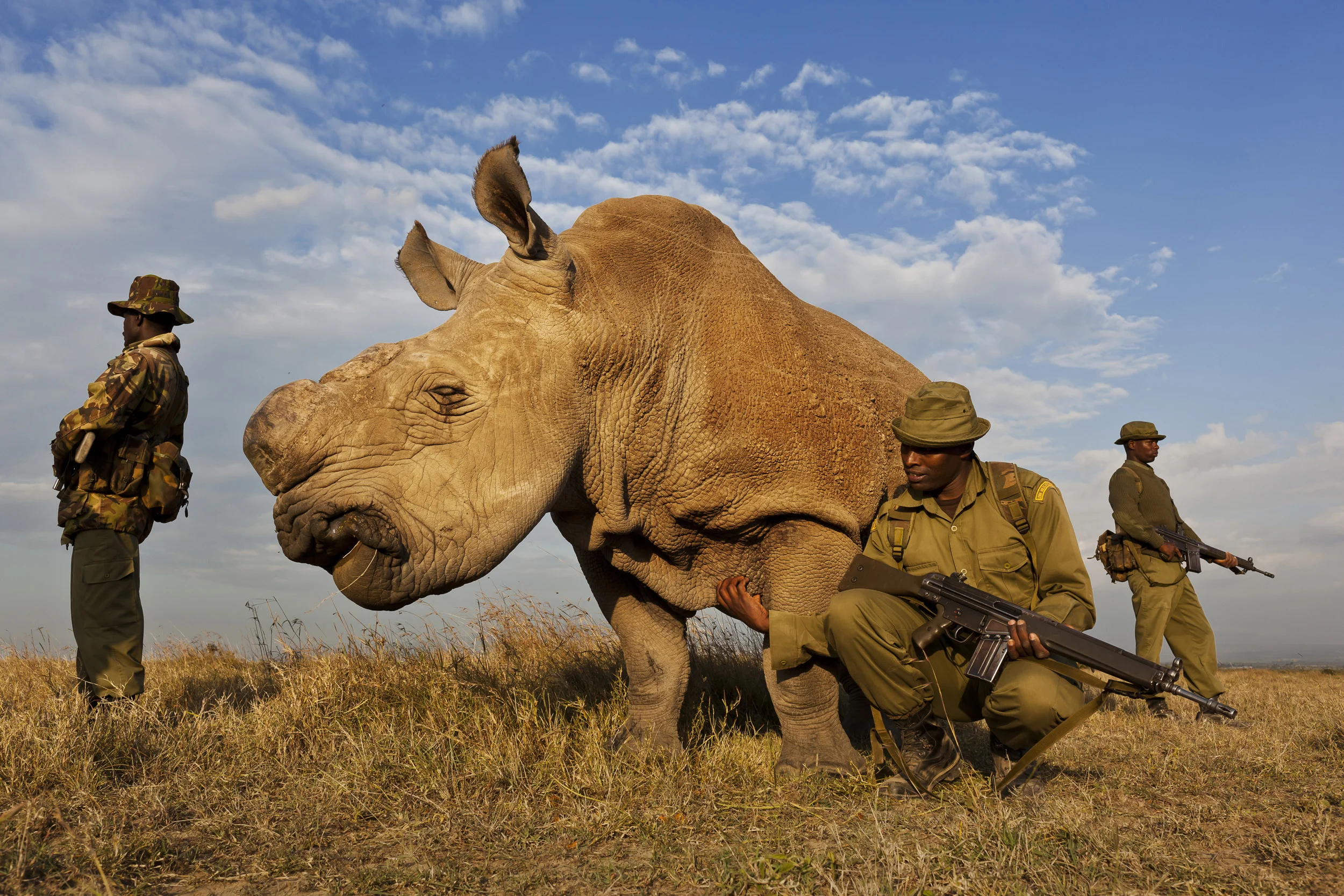
OL PEJETA CONSERVANCY, KENYA, JULY 2011: A four man anti-poaching team permanently guards Northern White Rhino on Ol Pejeta Conservancy in Kenya, 13 July 2011. The Ol Pejeta Conservancy is an important “not-for-profit” wildlife conservancy in the Laikipia District of Kenya and the largest sanctuary for black rhinos in East Africa. It is also the home of 4 of the world's remaining 8 Northern White Rhino, the worlds most endangered animal. There has been an increase in poaching incidents on Ol Pejeta recently, in line with a massive worldwide increase in rhino poaching linked to the rise in the Asian middle class. Anti-poaching teams provide close protection to the rhino, with 24 hour observation over all rhino on Ol Pejeta and 24 hour armed guard protection over the 4 Northern White Rhino who are kept in their own Boma area. The team have developed extraordinary relationships with these Rhino, leaning on them, scratching them and displaying tremendous affection towards these most endangered of animals. Each of the men in these teams feels a genuine vocation towards the protection of these animals, something the rhino seem to sense, and this emerges on a daily basis as the men walk with the rhino through their day. (Photo by Brent Stirton/Reportage for National Geographic.)

OL PEJETA CONSERVANCY, KENYA, JULY 2011: Exhausted anti-poaching team members sleep after an all-nighter on Ol Pejeta Conservancy in Kenya, 13 July 2011. The Ol Pejeta Conservancy is an important “not-for-profit” wildlife conservancy in the Laikipia District of Kenya and the largest sanctuary for black rhinos in East Africa. It is also the home of 4 of the world's remaining 8 Northern White Rhino. There has been an increase in poaching incidents on Ol Pejeta recently, in line with a massive worldwide increase in rhino poaching linked to the rise in the Asian middle class. Anti-poaching teams provide close protection to the rhino, with 24 hour observation over all rhino on Ol Pejeta and 24 hour armed guard protection over the 4 Northern White Rhino who are kept in their own Boma area. (Photo by Brent Stirton/Reportage for National Geographic.)
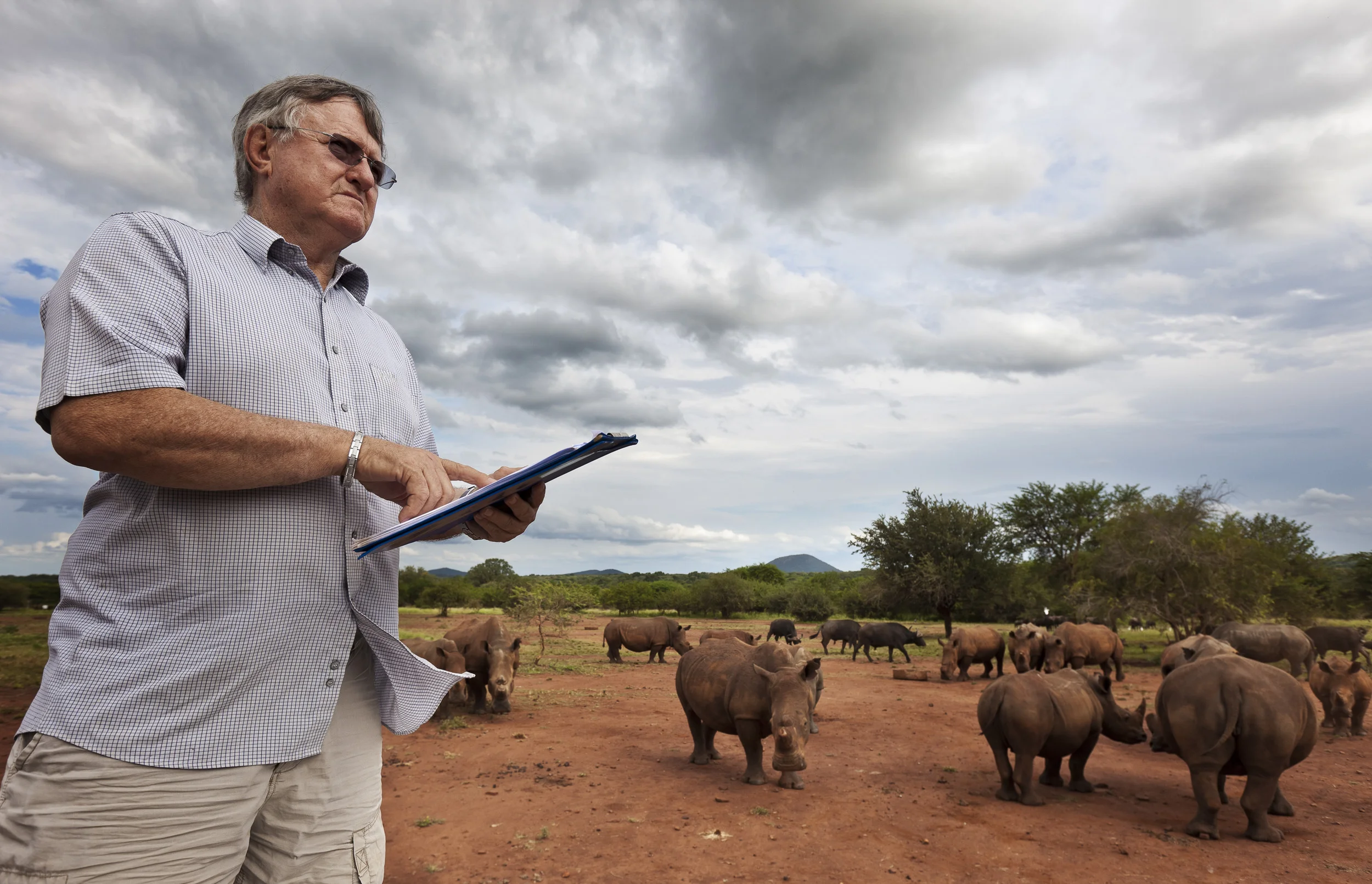
NELSPRUIT, NORTH EAST SOUTH AFRICA, MARCH 2011: The world's largest White Rhino breeder, John Hume, 69, looks out at a few of his 500 plus White Rhino as they come in from grazing on his 6500 Hectare ranch for a daily snack of lucerne mixed with game pellets, Nelspruit, South Africa, March 19 2011. A self made multi-millionaire, Hume is a controversial character in the conservation world. He advocates a sustainable consumption of rhino horn as a renewable resource as a method to combat the plague of poaching which killed 333 rhino in South Africa in 2010, the highest ever figures and the fastest acceleration of the killing of these unique animals in history. John Hume is adament in his believes that the insatiable Asian demand for Rhino horn and the subsequent illegal slaughter can only be curbed by a sustained, humane harvesting of horn from Rhino kept on large grazing farms by professional farmers for the purposes of commercial conservation. This brings him into direct conflict with much of the conservation world, despite the recent wide-spread popularity of darting and de-horning Rhino across much of South Africa as an anti-poaching deterrent. The rise of the Asian middle class, in particular China and Vietnam, combined with recent clampdowns on permits for legal Rhino hunting, has seen the price of Rhino horn sky-rocket to a level comparable with gold. John Hume has stated that he has well over $25 million worth of Rhino horn which is legally permitted and locked away in bank vaults across South Africa, waiting for a day when he hopes it will be legal to trade. In essence Hume is like a futures trader, gambling millions on the acquisition of White Rhino which he states is both a compassionate gesture and also a great business investment if the law-makers in the conservation world "could only see sense." Hume believes the Rhino has the resources through which to save itself from the threat of extinction. A fully grown horn can be harvested every 3 years with min

NELSPRUIT, NORTH EAST SOUTH AFRICA, MARCH 2011: De-horned White Rhino come in from grazing to be fed nutritious Lucerne and game pellets on Mauricedale, the 6500 hectare game ranch of the world's largest White Rhino breeder, John Hume, Nelspruit, South Africa, March 19, 2011. A self made multi-millionaire, Hume is a controversial character in the conservation world. He advocates a sustainable consumption of rhino horn as a renewable resource as a method to combat the plague of poaching which killed 333 rhino in South Africa in 2010, the highest ever figures and the fastest acceleration of the killing of these unique animals in history. John Hume is adament in his believes that the insatiable Asian demand for Rhino horn and the subsequent illegal slaughter can only be curbed by a sustained, humane harvesting of horn from Rhino kept on large grazing farms by professional farmers for the purposes of commercial conservation. This brings him into direct conflict with much of the conservation world, despite the recent wide-spread popularity of darting and de-horning Rhino across much of South Africa as an anti-poaching deterrent. The rise of the Asian middle class, in particular China and Vietnam, combined with recent clampdowns on permits for legal Rhino hunting, has seen the price of Rhino horn sky-rocket to a level comparable with gold. John Hume has stated that he has well over $25 million worth of Rhino horn which is legally permitted and locked away in bank vaults across South Africa, waiting for a day when he hopes it will be legal to trade. In essence Hume is like a futures trader, gambling millions on the acquisition of White Rhino which he states is both a compassionate gesture and also a great business investment if the law-makers in the conservation world "could only see sense." Hume believes the Rhino has the resources through which to save itself from the threat of extinction. A fully grown horn can be harvested every 3 years with minimal trauma to the ani

KLERKSDORP, SOUTH AFRICA, MARCH 2011: "Rambo," a 9 month old White Rhino orphan is raised by hand on a game farm outside of Klerksdorp after being abandoned by his mother at 5 days old, Klerksdorp, South Africa, March 25 2011. When he was found, Jackals had already begun eating his tail. He is now 200 kilograms and quickly becoming too big to handle safely. (Photo by Brent Stirton/Reportage for National Geographic Magazine.)

KLERKSDORP, SOUTH AFRICA, MARCH 2011: A White Rhino cow is de-horned as a precautionary anti-poaching measure on a game farm outside of Klerksdorp, South Africa, March 25 2011. Rhino Poaching has reached epedemic proportions in South Africa, with 334 killed in 2010 and 77 killed by the 25 March 2011. Many game farmers are increasingly turning to de-horning their animals as a protective measure against poaching. A 2 year study in Zimbabwe on the effects of de-horning has revealed no negative repercussions to the animal, and has seen less animals killed through fighting and horn damage. The horn grows back after 3 years to its full size without trauma to the animal and thus can be seen as a renewable, sustainable resource for the Asian markets if legalized. At this time the only legal means to obtain a horn in South Africa is through a permitted hunt with a member of the conservation authority present. This means that the animal has to die before the horn is available. Statistics on poaching prove that the lack of access to legal horn has seen poaching become common and the price of Rhino horn has reached an all time high. The counter argument to de-horning for profit is that it will lead to an interference in the natural world and an abuse of the resource in terms of animal treatment. Most Vets across South Africa have adopted de-horning as a neccesary anti-poaching technique to save the animals from being killed for their horn. On average a de-horning takes an experienced vet no more than 25 minutes to do from start to finish and the animal goes straight back to feeding with no visible sign of trauma afterwards. A standard 8 cms of stump is left behind, ensuring no actual tissue is ever damaged on the Rhino. The horns once taken are fitted with micro-chips, individually permitted and in most cases stored in bank vaults for security purposes. If the Rhino horn trade is ever legalised these horns will form the back bone of financial security for the farmers who take o
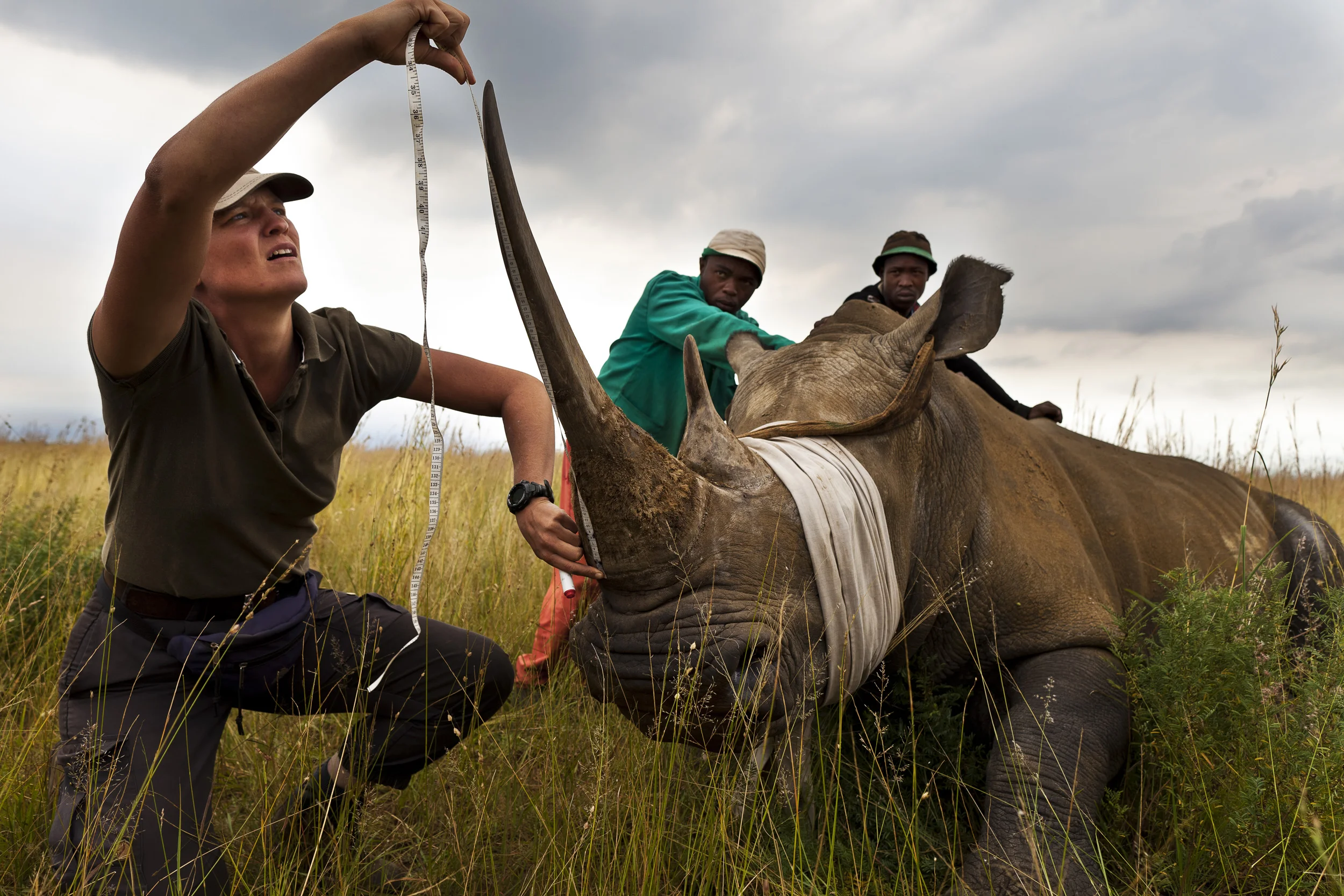
KLERKSDORP, SOUTH AFRICA, MARCH 2011: A White Rhino cow is de-horned as a precautionary anti-poaching measure on a game farm outside of Klerksdorp, South Africa, March 25 2011. Rhino Poaching has reached epedemic proportions in South Africa, with 334 killed in 2010 and 77 killed by the 25 March 2011. Many game farmers are increasingly turning to de-horning their animals as a protective measure against poaching. A 2 year study in Zimbabwe on the effects of de-horning has revealed no negative repercussions to the animal, and has seen less animals killed through fighting and horn damage. The horn grows back after 3 years to its full size without trauma to the animal and thus can be seen as a renewable, sustainable resource for the Asian markets if legalized. At this time the only legal means to obtain a horn in South Africa is through a permitted hunt with a member of the conservation authority present. This means that the animal has to die before the horn is available. Statistics on poaching prove that the lack of access to legal horn has seen poaching become common and the price of Rhino horn has reached an all time high. The counter argument to de-horning for profit is that it will lead to an interference in the natural world and an abuse of the resource in terms of animal treatment. Most Vets across South Africa have adopted de-horning as a neccesary anti-poaching technique to save the animals from being killed for their horn. On average a de-horning takes an experienced vet no more than 25 minutes to do from start to finish and the animal goes straight back to feeding with no visible sign of trauma afterwards. A standard 8 cms of stump is left behind, ensuring no actual tissue is ever damaged on the Rhino. The horns once taken are fitted with micro-chips, individually permitted and in most cases stored in bank vaults for security purposes. If the Rhino horn trade is ever legalised these horns will form the back bone of financial security for the farmers who take o
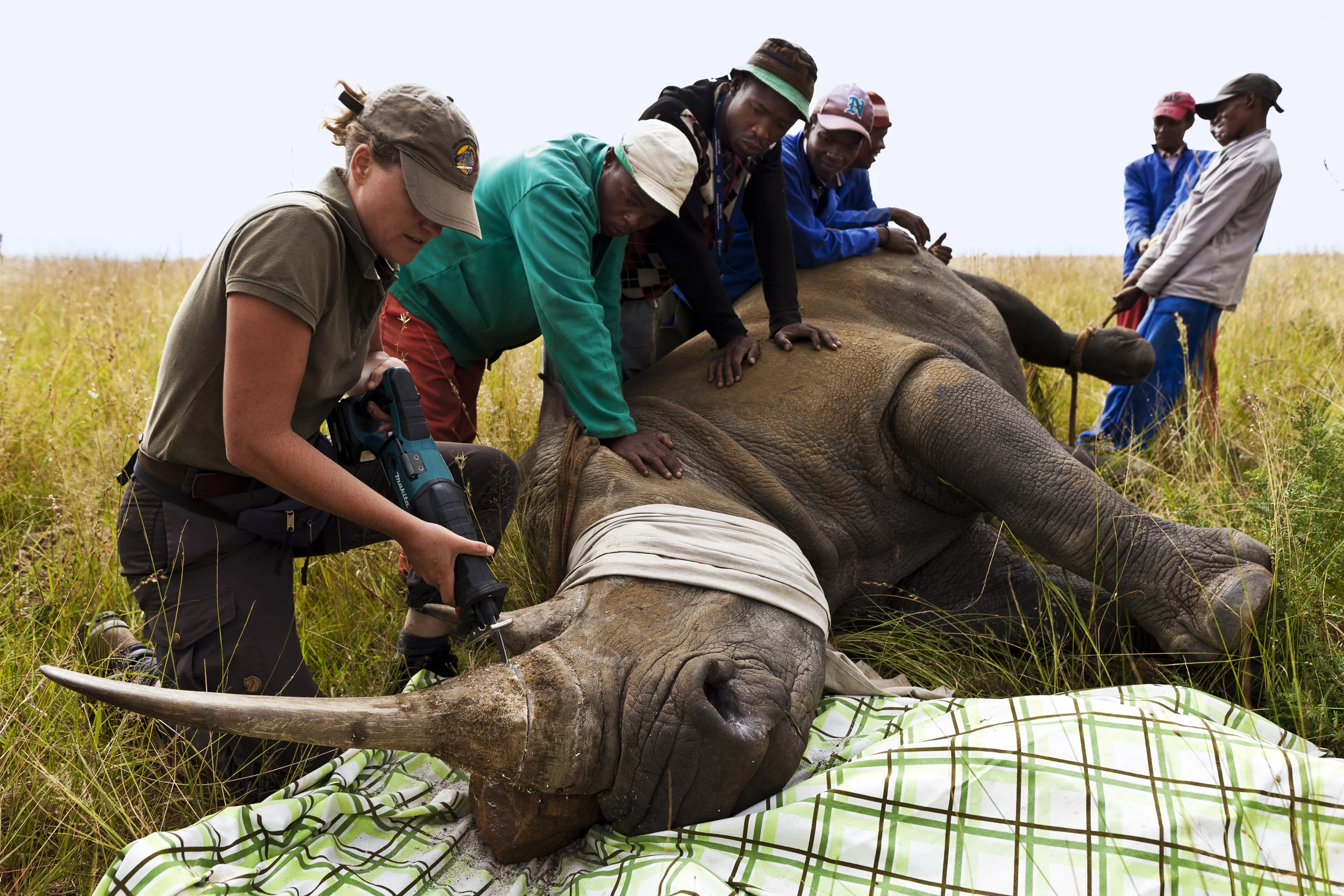
KLERKSDORP, SOUTH AFRICA, MARCH 2011: A White Rhino cow is de-horned as a precautionary anti-poaching measure on a game farm outside of Klerksdorp, South Africa, March 25 2011. Rhino Poaching has reached epedemic proportions in South Africa, with 334 killed in 2010 and 77 killed by the 25 March 2011. Many game farmers are increasingly turning to de-horning their animals as a protective measure against poaching. A 2 year study in Zimbabwe on the effects of de-horning has revealed no negative repercussions to the animal, and has seen less animals killed through fighting and horn damage. The horn grows back after 3 years to its full size without trauma to the animal and thus can be seen as a renewable, sustainable resource for the Asian markets if legalized. At this time the only legal means to obtain a horn in South Africa is through a permitted hunt with a member of the conservation authority present. This means that the animal has to die before the horn is available. Statistics on poaching prove that the lack of access to legal horn has seen poaching become common and the price of Rhino horn has reached an all time high. The counter argument to de-horning for profit is that it will lead to an interference in the natural world and an abuse of the resource in terms of animal treatment. Most Vets across South Africa have adopted de-horning as a neccesary anti-poaching technique to save the animals from being killed for their horn. On average a de-horning takes an experienced vet no more than 25 minutes to do from start to finish and the animal goes straight back to feeding with no visible sign of trauma afterwards. A standard 8 cms of stump is left behind, ensuring no actual tissue is ever damaged on the Rhino. The horns once taken are fitted with micro-chips, individually permitted and in most cases stored in bank vaults for security purposes. If the Rhino horn trade is ever legalised these horns will form the back bone of financial security for the farmers who take o

KLERKSDORP, SOUTH AFRICA, MARCH 2011: A White Rhino cow is de-horned as a precautionary anti-poaching measure on a game farm outside of Klerksdorp, South Africa, March 25 2011. Rhino Poaching has reached epedemic proportions in South Africa, with 334 killed in 2010 and 77 killed by the 25 March 2011. Many game farmers are increasingly turning to de-horning their animals as a protective measure against poaching. A 2 year study in Zimbabwe on the effects of de-horning has revealed no negative repercussions to the animal, and has seen less animals killed through fighting and horn damage. The horn grows back after 3 years to its full size without trauma to the animal and thus can be seen as a renewable, sustainable resource for the Asian markets if legalized. At this time the only legal means to obtain a horn in South Africa is through a permitted hunt with a member of the conservation authority present. This means that the animal has to die before the horn is available. Statistics on poaching prove that the lack of access to legal horn has seen poaching become common and the price of Rhino horn has reached an all time high. The counter argument to de-horning for profit is that it will lead to an interference in the natural world and an abuse of the resource in terms of animal treatment. Most Vets across South Africa have adopted de-horning as a neccesary anti-poaching technique to save the animals from being killed for their horn. On average a de-horning takes an experienced vet no more than 25 minutes to do from start to finish and the animal goes straight back to feeding with no visible sign of trauma afterwards. A standard 8 cms of stump is left behind, ensuring no actual tissue is ever damaged on the Rhino. The horns once taken are fitted with micro-chips, individually permitted and in most cases stored in bank vaults for security purposes. If the Rhino horn trade is ever legalised these horns will form the back bone of financial security for the farmers who take o

KLERKSDORP, SOUTH AFRICA, MARCH 2011: A White Rhino cow is de-horned as a precautionary anti-poaching measure on a game farm outside of Klerksdorp, South Africa, March 25 2011. Rhino Poaching has reached epedemic proportions in South Africa, with 334 killed in 2010 and 77 killed by the 25 March 2011. Many game farmers are increasingly turning to de-horning their animals as a protective measure against poaching. A 2 year study in Zimbabwe on the effects of de-horning has revealed no negative repercussions to the animal, and has seen less animals killed through fighting and horn damage. The horn grows back after 3 years to its full size without trauma to the animal and thus can be seen as a renewable, sustainable resource for the Asian markets if legalized. At this time the only legal means to obtain a horn in South Africa is through a permitted hunt with a member of the conservation authority present. This means that the animal has to die before the horn is available. Statistics on poaching prove that the lack of access to legal horn has seen poaching become common and the price of Rhino horn has reached an all time high. The counter argument to de-horning for profit is that it will lead to an interference in the natural world and an abuse of the resource in terms of animal treatment. Most Vets across South Africa have adopted de-horning as a neccesary anti-poaching technique to save the animals from being killed for their horn. On average a de-horning takes an experienced vet no more than 25 minutes to do from start to finish and the animal goes straight back to feeding with no visible sign of trauma afterwards. A standard 8 cms of stump is left behind, ensuring no actual tissue is ever damaged on the Rhino. The horns once taken are fitted with micro-chips, individually permitted and in most cases stored in bank vaults for security purposes. If the Rhino horn trade is ever legalised these horns will form the back bone of financial security for the farmers who take o
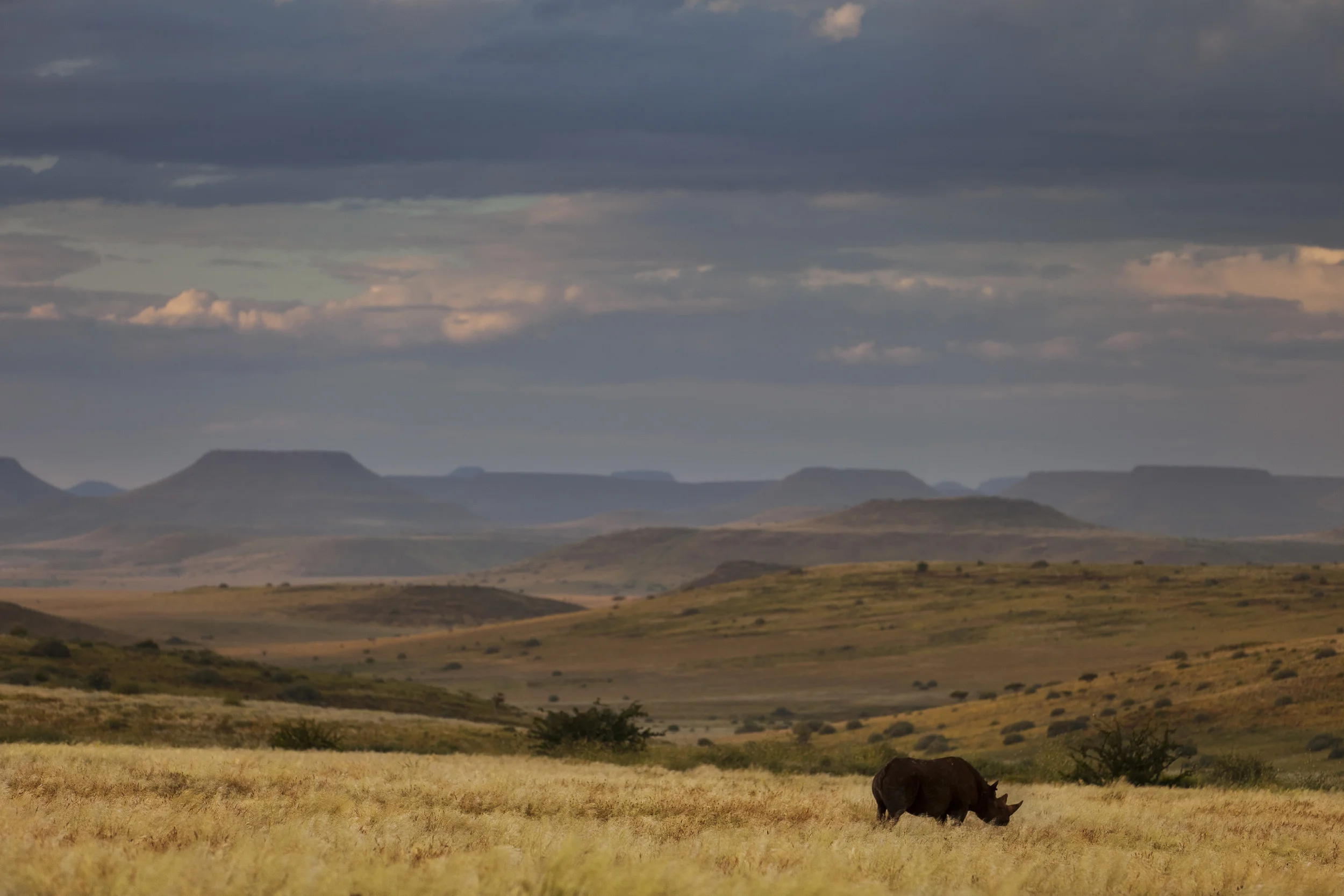
DAMARALAND, NORTH KUNEINE, NAMIBIA, APRIL 2011: Images of the Damaraland region of Namibia, the last place in the world where Black Rhino still roam freely, Namibia, April 18 2011. The desert adapted black rhino that survive in the remote and arid Kunene region of north west Namibia are the ONLY rhino world-wide that have survived on communal land with no conservation status. They are in the fullest sense of the word truly wild. No fences. No borders. They live and go where they please. Namibia represents a success story for Rhino at a time where they are severely under threat everywhere else in the world. There have been successful breeding programs in these extremely remote regions, buy-in from local communities for tourist dollars has reinforced these programs and Save The Rhino Trust Namibia has provided community training and Ranger patrols made up of different ethnicities from the regional communities. For now, these factors have kept the Black Rhino of Namibia safe from poaching, previously an epedemic in the region. (Photo by Brent Stirton/National Geographic magazine.) **Overview from SAVE THE RHINO TRUST NAMIBIA: The desert-adapted black rhino (Diceros bicornis bicornis) surviving in the Kunene Region (former Damaraland and Kaokoland) in the arid, north-west of Namibia are the only rhino worldwide, surviving on communal land with no formal conservation status. Furthermore, they are the largest truly free-ranging black rhino population left in the world.However, in the early 1980’s in this vast, beautiful and spectacular desert, a savage slaughter of desert wildlife took place. As the number of rhinos shrank, resulting in their near extinction, a Trust was formed with the aim of ensuring protection of the remaining rhinos while affording, elephant and other wildlife, the chance to recover to sustainable numbers. With the help of international funds, Save the Rhino Trust - Namibia was officially registered as Welfare Organization number W.O. 53.in 1982.I

DAMARALAND, NORTH KUNEINE, NAMIBIA, APRIL 2011: Images of the Damaraland region of Namibia, the last place in the world where Black Rhino still roam freely, Namibia, April 18 2011. The desert adapted black rhino that survive in the remote and arid Kunene region of north west Namibia are the ONLY rhino world-wide that have survived on communal land with no conservation status. They are in the fullest sense of the word truly wild. No fences. No borders. They live and go where they please. Namibia represents a success story for Rhino at a time where they are severely under threat everywhere else in the world. There have been successful breeding programs in these extremely remote regions, buy-in from local communities for tourist dollars has reinforced these programs and Save The Rhino Trust Namibia has provided community training and Ranger patrols made up of different ethnicities from the regional communities. For now, these factors have kept the Black Rhino of Namibia safe from poaching, previously an epedemic in the region. (Photo by Brent Stirton/National Geographic magazine.) **Overview from SAVE THE RHINO TRUST NAMIBIA: The desert-adapted black rhino (Diceros bicornis bicornis) surviving in the Kunene Region (former Damaraland and Kaokoland) in the arid, north-west of Namibia are the only rhino worldwide, surviving on communal land with no formal conservation status. Furthermore, they are the largest truly free-ranging black rhino population left in the world.However, in the early 1980’s in this vast, beautiful and spectacular desert, a savage slaughter of desert wildlife took place. As the number of rhinos shrank, resulting in their near extinction, a Trust was formed with the aim of ensuring protection of the remaining rhinos while affording, elephant and other wildlife, the chance to recover to sustainable numbers. With the help of international funds, Save the Rhino Trust - Namibia was officially registered as Welfare Organization number W.O. 53.in 1982.I

iMFOLOZI GAME RESERVE, NATAL, SOUTH AFRICA, MAY 2011: Images of a White Rhino cow and calf in iMfolozi Game Reserve in Natal, South Africa, May 3, 2011. Hluwhluwe iMfolozi Game Reserve is the worlds largest repository of Rhino, with an estimated 2300 rhino in total, a majority of which are White and a large contingent of Black Rhino. (Photo by Brent Stirton/Reportage for National Geographic Magazine.)
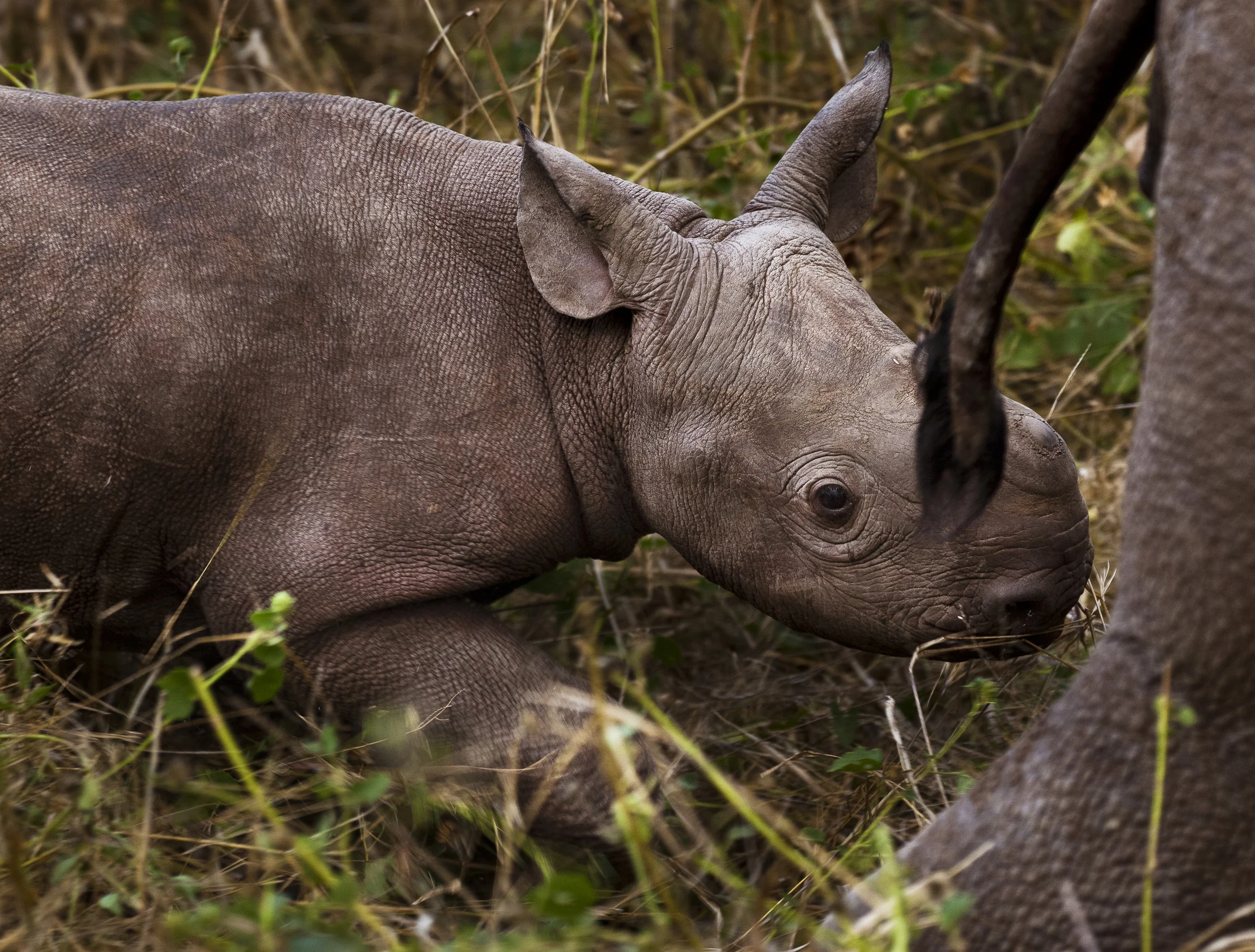
VICTORIA FALLS, ZIMBABWE, APRIL 2011: Images of a 3 week old Black Rhino Calf born at the Victoria Falls Private Game Reserve, Zimbabwe, April 25, 2011. (Photo by Brent Stirton/Reportage for National Geographic Magazine.)

VICTORIA FALLS, ZIMBABWE, APRIL 2011: Images of a 3 week old Black Rhino Calf born at the Victoria Falls Private Game Reserve, Zimbabwe, April 25, 2011. (Photo by Brent Stirton/Reportage for National Geographic Magazine.)

VICTORIA FALLS, ZIMBABWE, APRIL 2011: Images of a 3 week old Black Rhino Calf born at the Victoria Falls Private Game Reserve, Zimbabwe, April 25, 2011. (Photo by Brent Stirton/Reportage for National Geographic Magazine.)
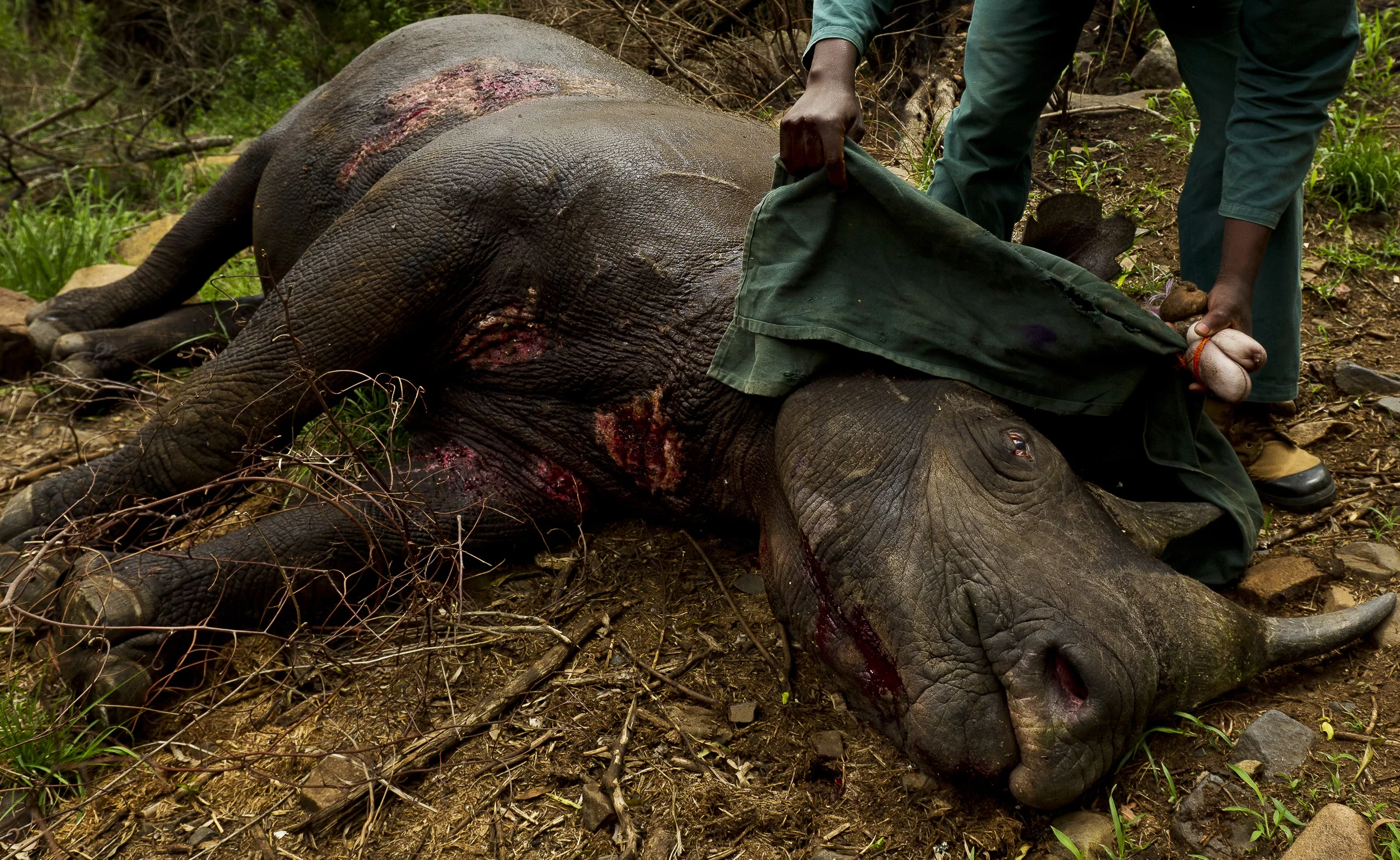
HLUHLUWE-iMFOLOZI PARK, SOUTH AFRICA, NOVEMBER 2010: Images of Black Rhino capture for Translocation at Hluhluwe-iMfolozi Park, South Africa, November 7, 2010. This park is famous for its translocation programs which saved the Southern White Rhino from extinction. WWF is involved in funding for security operations in the Park and also creates new Black Rhino population in an effort to replicate the success of the White Rhino translocation program. The Black Rhino remains critically endangered in Africa today. 247 Rhinos have been killed for their horns so far in 2010 in South Africa, a tenfold increase over previous years. WWF’s Black Rhino Range Expansion Project (BRREP) is successfully expanding the range of the Black Rhino outside of the Ezemvelo KZN Wildlife protected areas into private- and community-owned land. BRREP project manager, Jacques Flamand, said: “Our approach is to develop strong partnerships with communities and private owners. They must comply with strict criteria regarding the management of Black Rhino – from security to land size - before we move the animals onto their land. The project has increased the Black Rhino population and reduced its critically endangered status. Black Rhino require an extensive range – in northern KwaZulu Natal the carrying capacity is 300 to 400 hectares per Black Rhino. The Black Rhino is a flagship species that attracts tourists and helps extend the conservation footprint in this region. (Photo by Brent Stirton/Reportage for WWF)

HLUHLUWE-iMFOLOZI PARK, SOUTH AFRICA, NOVEMBER 2010: Images of Black Rhino capture for Translocation at Hluhluwe-iMfolozi Park, South Africa, November 7, 2010. This park is famous for its translocation programs which saved the Southern White Rhino from extinction. WWF is involved in funding for security operations in the Park and also creates new Black Rhino population in an effort to replicate the success of the White Rhino translocation program. The Black Rhino remains critically endangered in Africa today. 247 Rhinos have been killed for their horns so far in 2010 in South Africa, a tenfold increase over previous years. WWF’s Black Rhino Range Expansion Project (BRREP) is successfully expanding the range of the Black Rhino outside of the Ezemvelo KZN Wildlife protected areas into private- and community-owned land. BRREP project manager, Jacques Flamand, said: “Our approach is to develop strong partnerships with communities and private owners. They must comply with strict criteria regarding the management of Black Rhino – from security to land size - before we move the animals onto their land. The project has increased the Black Rhino population and reduced its critically endangered status. Black Rhino require an extensive range – in northern KwaZulu Natal the carrying capacity is 300 to 400 hectares per Black Rhino. The Black Rhino is a flagship species that attracts tourists and helps extend the conservation footprint in this region. (Photo by Brent Stirton/Reportage for WWF)

HLUHLUWE-iMFOLOZI PARK, SOUTH AFRICA, NOVEMBER 2010: Images of Black Rhino capture for Translocation at Hluhluwe-iMfolozi Park, South Africa, November 7, 2010. This park is famous for its translocation programs which saved the Southern White Rhino from extinction. WWF is involved in funding for security operations in the Park and also creates new Black Rhino population in an effort to replicate the success of the White Rhino translocation program. The Black Rhino remains critically endangered in Africa today. 247 Rhinos have been killed for their horns so far in 2010 in South Africa, a tenfold increase over previous years. WWF’s Black Rhino Range Expansion Project (BRREP) is successfully expanding the range of the Black Rhino outside of the Ezemvelo KZN Wildlife protected areas into private- and community-owned land. BRREP project manager, Jacques Flamand, said: “Our approach is to develop strong partnerships with communities and private owners. They must comply with strict criteria regarding the management of Black Rhino – from security to land size - before we move the animals onto their land. The project has increased the Black Rhino population and reduced its critically endangered status. Black Rhino require an extensive range – in northern KwaZulu Natal the carrying capacity is 300 to 400 hectares per Black Rhino. The Black Rhino is a flagship species that attracts tourists and helps extend the conservation footprint in this region. (Photo by Brent Stirton/Reportage for WWF)

HLUHLUWE-iMFOLOZI PARK, SOUTH AFRICA, NOVEMBER 2010: Images of Black Rhino capture for Translocation at Hluhluwe-iMfolozi Park, South Africa, November 7, 2010. This park is famous for its translocation programs which saved the Southern White Rhino from extinction. WWF is involved in funding for security operations in the Park and also creates new Black Rhino population in an effort to replicate the success of the White Rhino translocation program. The Black Rhino remains critically endangered in Africa today. 247 Rhinos have been killed for their horns so far in 2010 in South Africa, a tenfold increase over previous years. WWF’s Black Rhino Range Expansion Project (BRREP) is successfully expanding the range of the Black Rhino outside of the Ezemvelo KZN Wildlife protected areas into private- and community-owned land. BRREP project manager, Jacques Flamand, said: “Our approach is to develop strong partnerships with communities and private owners. They must comply with strict criteria regarding the management of Black Rhino – from security to land size - before we move the animals onto their land. The project has increased the Black Rhino population and reduced its critically endangered status. Black Rhino require an extensive range – in northern KwaZulu Natal the carrying capacity is 300 to 400 hectares per Black Rhino. The Black Rhino is a flagship species that attracts tourists and helps extend the conservation footprint in this region. (Photo by Brent Stirton/Reportage for WWF)

HLUHLUWE-iMFOLOZI PARK, SOUTH AFRICA, NOVEMBER 2010: Images of Black Rhino capture for Translocation at Hluhluwe-iMfolozi Park, South Africa, November 7, 2010. This park is famous for its translocation programs which saved the Southern White Rhino from extinction. WWF is involved in funding for security operations in the Park and also creates new Black Rhino population in an effort to replicate the success of the White Rhino translocation program. The Black Rhino remains critically endangered in Africa today. 247 Rhinos have been killed for their horns so far in 2010 in South Africa, a tenfold increase over previous years. WWF’s Black Rhino Range Expansion Project (BRREP) is successfully expanding the range of the Black Rhino outside of the Ezemvelo KZN Wildlife protected areas into private- and community-owned land. BRREP project manager, Jacques Flamand, said: “Our approach is to develop strong partnerships with communities and private owners. They must comply with strict criteria regarding the management of Black Rhino – from security to land size - before we move the animals onto their land. The project has increased the Black Rhino population and reduced its critically endangered status. Black Rhino require an extensive range – in northern KwaZulu Natal the carrying capacity is 300 to 400 hectares per Black Rhino. The Black Rhino is a flagship species that attracts tourists and helps extend the conservation footprint in this region. (Photo by Brent Stirton/Reportage for WWF)

HLUHLUWE-iMFOLOZI PARK, SOUTH AFRICA, NOVEMBER 2010: Images of Black Rhino capture for Translocation at Hluhluwe-iMfolozi Park, South Africa, November 7, 2010. This park is famous for its translocation programs which saved the Southern White Rhino from extinction. WWF is involved in funding for security operations in the Park and also creates new Black Rhino population in an effort to replicate the success of the White Rhino translocation program. The Black Rhino remains critically endangered in Africa today. 247 Rhinos have been killed for their horns so far in 2010 in South Africa, a tenfold increase over previous years. WWF’s Black Rhino Range Expansion Project (BRREP) is successfully expanding the range of the Black Rhino outside of the Ezemvelo KZN Wildlife protected areas into private- and community-owned land. BRREP project manager, Jacques Flamand, said: “Our approach is to develop strong partnerships with communities and private owners. They must comply with strict criteria regarding the management of Black Rhino – from security to land size - before we move the animals onto their land. The project has increased the Black Rhino population and reduced its critically endangered status. Black Rhino require an extensive range – in northern KwaZulu Natal the carrying capacity is 300 to 400 hectares per Black Rhino. The Black Rhino is a flagship species that attracts tourists and helps extend the conservation footprint in this region. (Photo by Brent Stirton/Reportage for WWF)

HLUHLUWE-iMFOLOZI PARK, SOUTH AFRICA, NOVEMBER 2010: Images of Black Rhino capture for Translocation at Hluhluwe-iMfolozi Park, South Africa, November 7, 2010. This park is famous for its translocation programs which saved the Southern White Rhino from extinction. WWF is involved in funding for security operations in the Park and also creates new Black Rhino population in an effort to replicate the success of the White Rhino translocation program. The Black Rhino remains critically endangered in Africa today. 247 Rhinos have been killed for their horns so far in 2010 in South Africa, a tenfold increase over previous years. WWF’s Black Rhino Range Expansion Project (BRREP) is successfully expanding the range of the Black Rhino outside of the Ezemvelo KZN Wildlife protected areas into private- and community-owned land. BRREP project manager, Jacques Flamand, said: “Our approach is to develop strong partnerships with communities and private owners. They must comply with strict criteria regarding the management of Black Rhino – from security to land size - before we move the animals onto their land. The project has increased the Black Rhino population and reduced its critically endangered status. Black Rhino require an extensive range – in northern KwaZulu Natal the carrying capacity is 300 to 400 hectares per Black Rhino. The Black Rhino is a flagship species that attracts tourists and helps extend the conservation footprint in this region. (Photo by Brent Stirton/Reportage for WWF)

HLUHLUWE-iMFOLOZI PARK, SOUTH AFRICA, NOVEMBER 2010: Images of Black Rhino capture for Translocation at Hluhluwe-iMfolozi Park, South Africa, November 7, 2010. This park is famous for its translocation programs which saved the Southern White Rhino from extinction. WWF is involved in funding for security operations in the Park and also creates new Black Rhino population in an effort to replicate the success of the White Rhino translocation program. The Black Rhino remains critically endangered in Africa today. 247 Rhinos have been killed for their horns so far in 2010 in South Africa, a tenfold increase over previous years. WWF’s Black Rhino Range Expansion Project (BRREP) is successfully expanding the range of the Black Rhino outside of the Ezemvelo KZN Wildlife protected areas into private- and community-owned land. BRREP project manager, Jacques Flamand, said: “Our approach is to develop strong partnerships with communities and private owners. They must comply with strict criteria regarding the management of Black Rhino – from security to land size - before we move the animals onto their land. The project has increased the Black Rhino population and reduced its critically endangered status. Black Rhino require an extensive range – in northern KwaZulu Natal the carrying capacity is 300 to 400 hectares per Black Rhino. The Black Rhino is a flagship species that attracts tourists and helps extend the conservation footprint in this region. (Photo by Brent Stirton/Reportage for WWF)

HLUHLUWE-iMFOLOZI PARK, SOUTH AFRICA, NOVEMBER 2010: Images of Black Rhino capture for Translocation at Hluhluwe-iMfolozi Park, South Africa, November 7, 2010. This park is famous for its translocation programs which saved the Southern White Rhino from extinction. WWF is involved in funding for security operations in the Park and also creates new Black Rhino population in an effort to replicate the success of the White Rhino translocation program. The Black Rhino remains critically endangered in Africa today. 247 Rhinos have been killed for their horns so far in 2010 in South Africa, a tenfold increase over previous years. WWF’s Black Rhino Range Expansion Project (BRREP) is successfully expanding the range of the Black Rhino outside of the Ezemvelo KZN Wildlife protected areas into private- and community-owned land. BRREP project manager, Jacques Flamand, said: “Our approach is to develop strong partnerships with communities and private owners. They must comply with strict criteria regarding the management of Black Rhino – from security to land size - before we move the animals onto their land. The project has increased the Black Rhino population and reduced its critically endangered status. Black Rhino require an extensive range – in northern KwaZulu Natal the carrying capacity is 300 to 400 hectares per Black Rhino. The Black Rhino is a flagship species that attracts tourists and helps extend the conservation footprint in this region. (Photo by Brent Stirton/Reportage for WWF)

HLUHLUWE UMFOLOZI GAME RESERVE, KWAZULU-NATAL, SOUTH AFRICA: Images of Rhino inside the capture Bomas at Hluhluwe Umfolozi Game Reserve waiting to be transported to St Lucia as part of a translocation program designed to distribute both Black and White Rhino to secure locations within South Africa, 29 April 2011. (Photo by Brent Stirton/Reportage for National Geographic Magazine.)
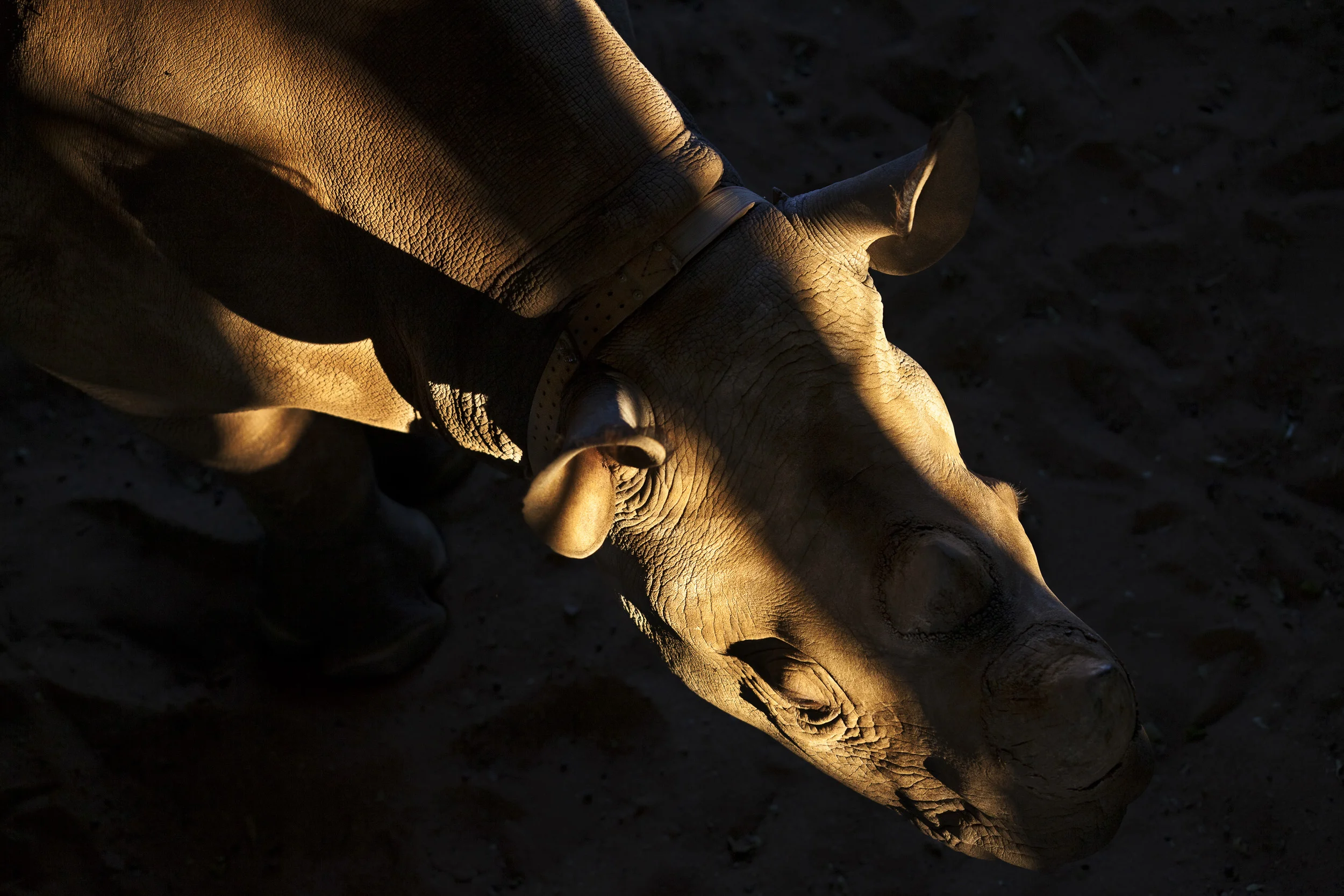
iMFOLOZI HLUHLUWE GAME RESERVE, NATAL, SOUTH AFRICA, MAY 2011: Images of a young Black Rhino Rhino who has grown up in captivity after being orphaned at a young age in iMfolozi Game Reserve in Natal, South Africa, May 2, 2011. Hluwhluwe iMfolozi Game Reserve is the worlds largest repository of Rhino, with an estimated 2300 rhino in total, a majority of which are White and a large contingent of Black Rhino. (Photo by Brent Stirton/Reportage for National Geographic Magazine.)
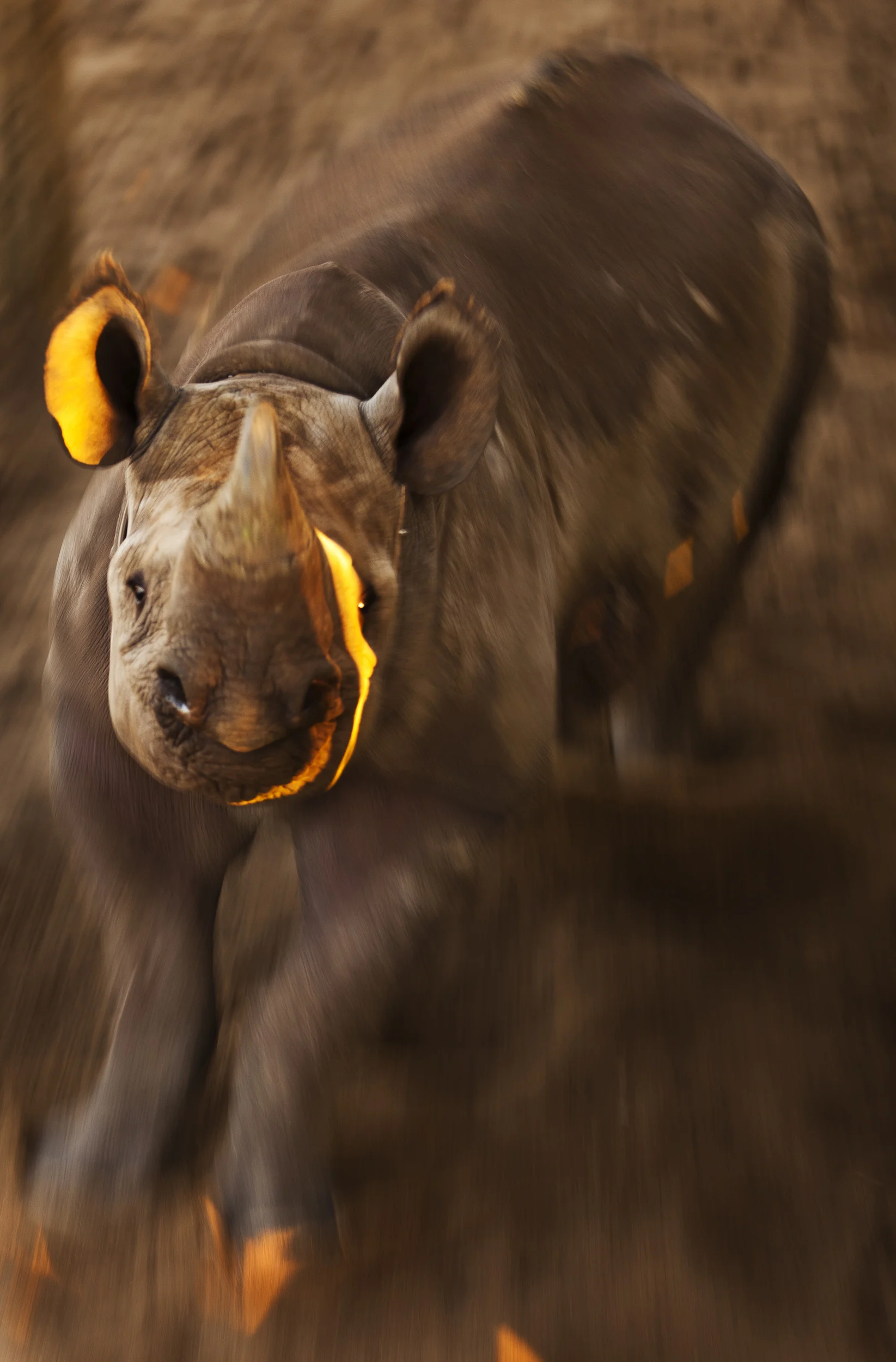
iMFOLOZI HLUHLUWE GAME RESERVE, NATAL, SOUTH AFRICA, MAY 2011: Images of a young Black Rhino Rhino who has grown up in captivity after being orphaned at a young age in iMfolozi Game Reserve in Natal, South Africa, May 2, 2011. Hluwhluwe iMfolozi Game Reserve is the worlds largest repository of Rhino, with an estimated 2300 rhino in total, a majority of which are White and a large contingent of Black Rhino. (Photo by Brent Stirton/Reportage for National Geographic Magazine.)
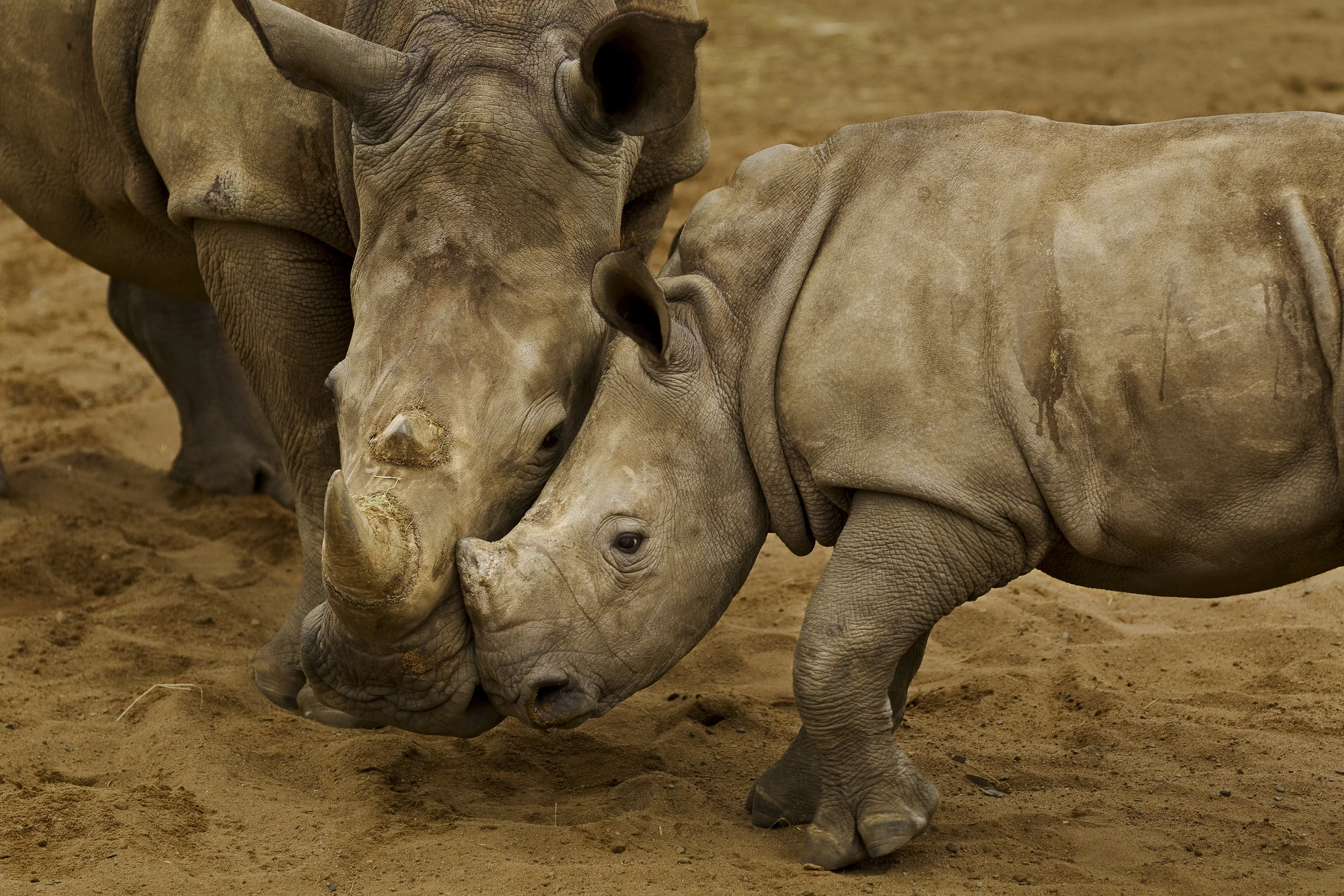
HLUHLUWE-iMFOLOZI PARK, SOUTH AFRICA, NOVEMBER 2010: Images of a White Rhino calf, mother and juvenile male in holding pens at Hluhluwe-iMfolozi Park, South Africa, November 6 2010. This park is famous for its translocation programs which saved the Southern White Rhino from extinction. WWF is involved in funding for security operations in the Park and also creates new Black Rhino population in an effort to replicate the success of the White Rhino translocation program. The Black Rhino remains critically endangered in Africa today. 247 Rhinos have been killed for their horns so far in 2010 in South Africa, a tenfold increase over previous years. (Photo by Brent Stirton/Reportage for WWF)

HLUHLUWE-iMFOLOZI PARK, SOUTH AFRICA, NOVEMBER 2010: Images of a White Rhino calf, mother and juvenile male in holding pens at Hluhluwe-iMfolozi Park, South Africa, November 6 2010. This park is famous for its translocation programs which saved the Southern White Rhino from extinction. WWF is involved in funding for security operations in the Park and also creates new Black Rhino population in an effort to replicate the success of the White Rhino translocation program. The Black Rhino remains critically endangered in Africa today. 247 Rhinos have been killed for their horns so far in 2010 in South Africa, a tenfold increase over previous years. (Photo by Brent Stirton/Reportage for WWF)


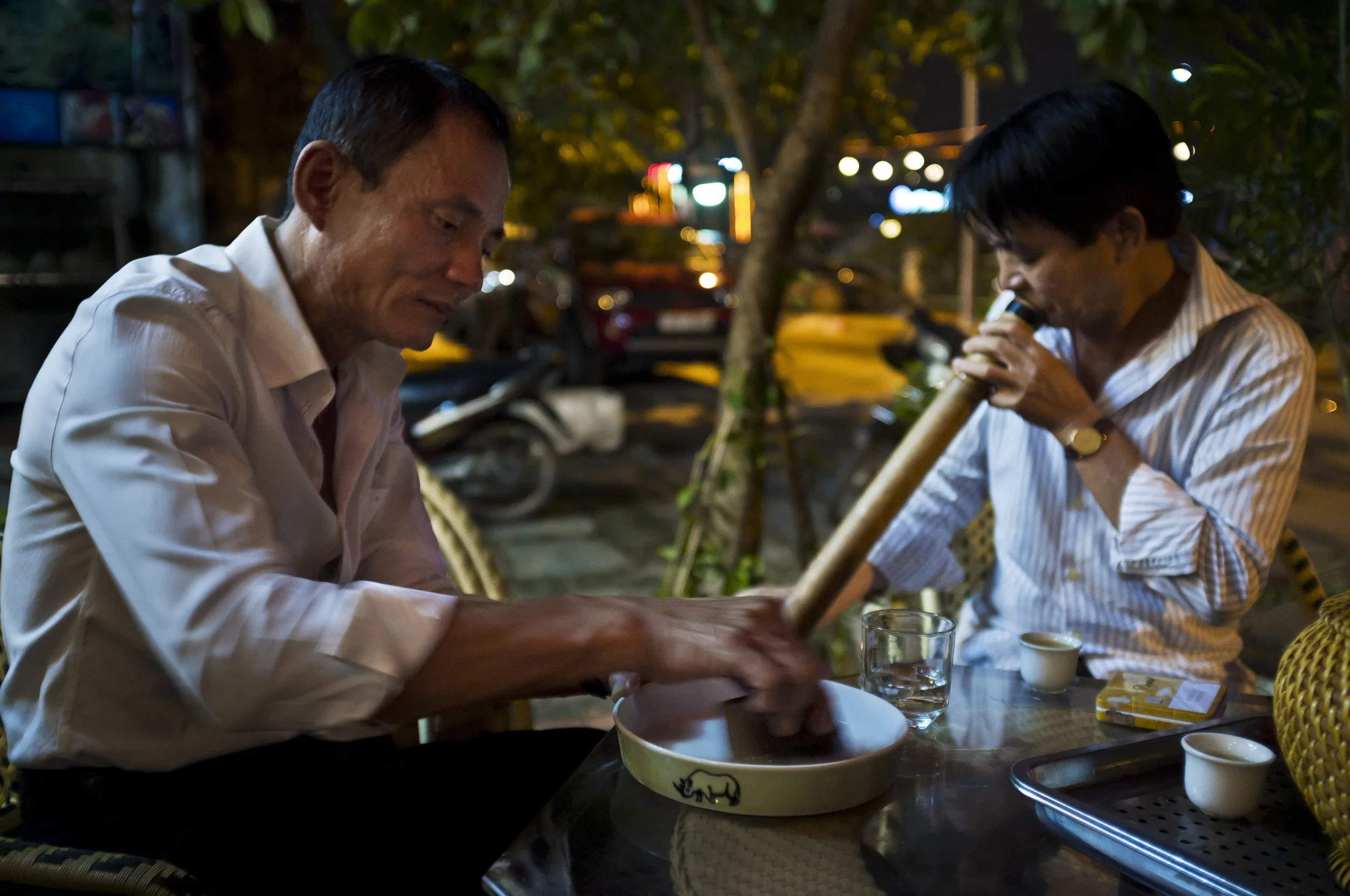


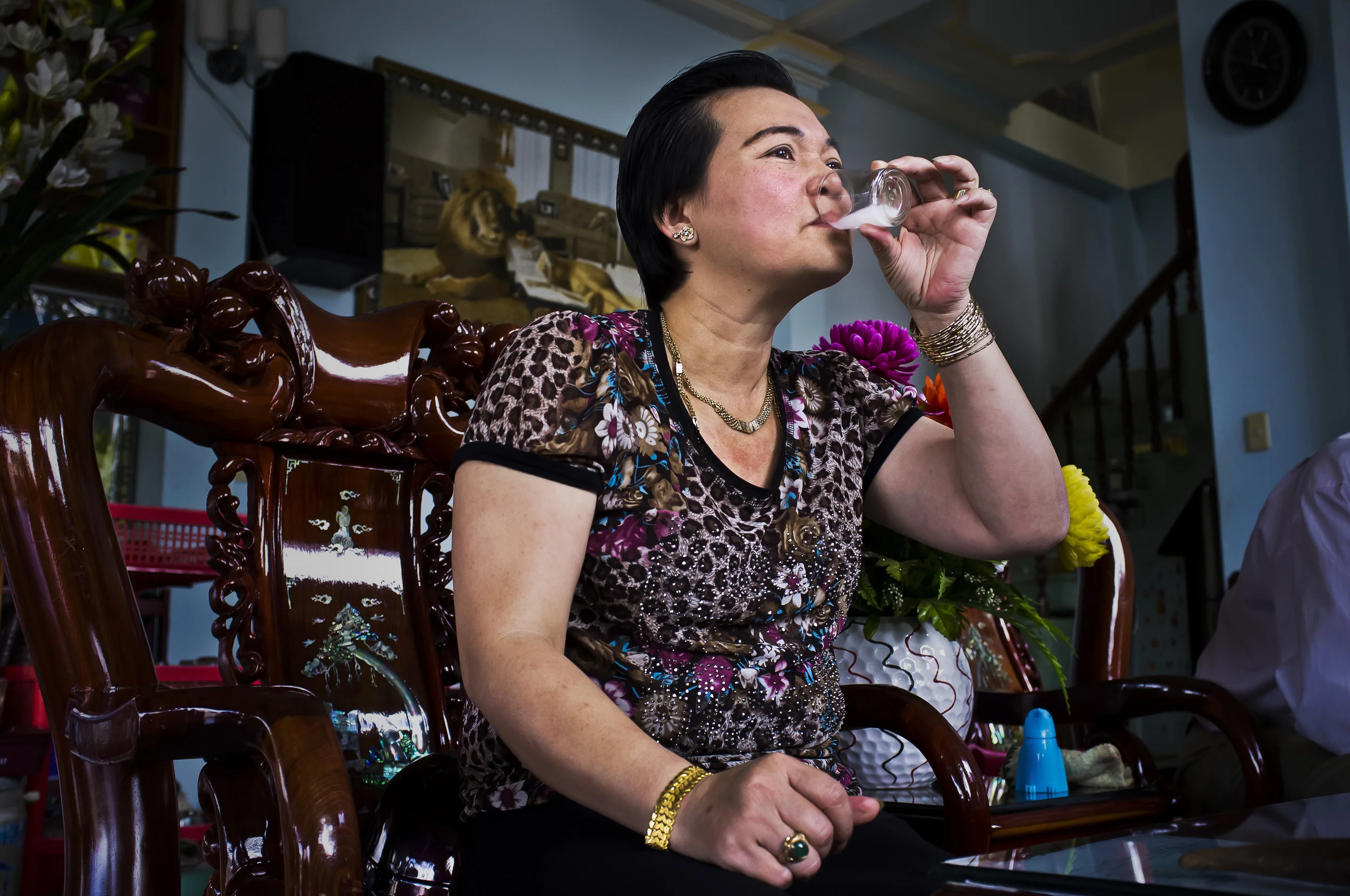
BAO LOC, LAM DONG PROVINCE, VIETNAM, OCTOBER 2011: A wealthy woman grinds illegal imported rhino horn openly in a coffee shop with her dealer sitting alongside her, Bao Loc, Vietnam, October 6 2011. The piece of horn she is grinding and the smaller piece on the table were until recently one piece, part of a larger illegal consignment which the dealer claims came into Vietnam through Malaysia or Indonesia. When asked whether they were concerned about grinding the horn in the open in a coffee shop, they laughed and said they paid the Vietnamese equivalent of $1500 every month to the police for protection. There was a policeman in the coffee shop at the time, at one point he is visible coming down the stairs. He is part of their system say the dealers. The wealthy woman claims she purchased the horn because she had kidney stones and is worried about cancer. Since using the horn, she claims to have increased energy, better skin and does not feel the kidney stones anymore. She says that she now uses the horn every day as a preventative measure. The irony of the horn trade today is that it is a centuries old practise in Vietnam, with mass belief in its power as an extractor of poisons and as a cure for measles. Nowadays however, the horn is so expensive it is only available to the upper middle class and the wealthy. The people who used it most over the centuries, ie the poor, can now no longer afford it. As a result of the demand amongst the poor, many people form groups and purchase the horn for the use of the group. (Photo by Brent Stirton/National Geographic magazine.)
